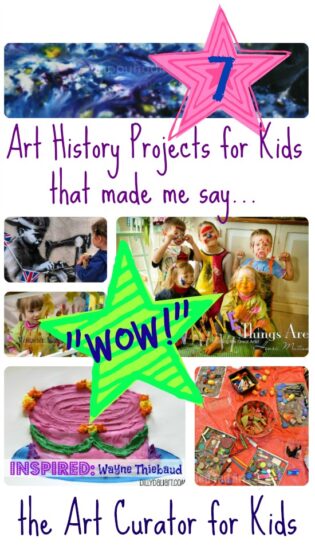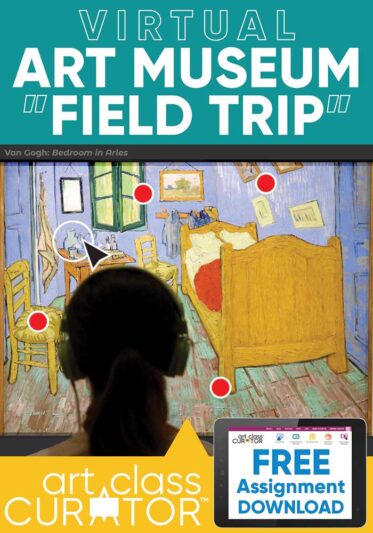I recently received a question from a reader that I didn’t have a great answer to. Charlotte P asked:
Hi Cindy, I am an art teacher in a charter school in St. Louis, MO. I love your website and all of the information that you have so lovingly shared with fellow art teachers. I am looking for a great way to measure progress with students. I thought of letting them grade themselves on craftsmanship, creativity, participation, and effort. These are vague-ish. I do think that each one is important and maybe I should focus on one at a time…I see students once a week for 50 minutes. I think they forget a lot of what we do together, but maybe if I focus on one goal for an extended amount of time? I want to make it engaging and valuable to them. What are your ideas?
When I taught elementary, I had this same struggle, and I never really did develop a great system for this. I decided to put the question out to you guys in a recent e-mail newsletter, on the Art History Teachers Facebook Group, and on my Facebook page, and I got some awesome responses! Thanks so much to everyone who responded. I went ahead and just copied the quotes directly since the ideas were so great!
How do you grade art? Hear ideas straight from these awesome art teachers!
Defining Effort
I teach 5th grade through 12th only two hours per week. (Mon & Tues 5th-6th, then 7-8th, then 9-12th). It is difficult to get a lot done with such minimal time but we ‘mostly’ work hard. I grade based on 1) Following instructions and 2) Effort. Effort includes craftsmanship and creativity. A student being careful, thoughtful, and/or creative shows effort of craftsmanship and the students understand this.
Student grades also include their sketchbooks which is 1/4 of their overall grade. Sketchbooks are homework although they all use them at the beginning of classes for a warm-up.
We sometimes use the “glow” “grow” method of critiquing each other’s work which looks promising for increasing effort.
Angie D.
Changing your Method as Students Age
A great deal of an art grade is the age of the child and your goals for the class. Young children simply need to be encouraged to create, not focus on technique. If a young child puts a great effort on it, score high. It does not matter what it looks like. As they age, there are more specific learning goals to art, some should be technical knowledge of the subject matter, which can be tested objectively. Then technique comes into play, and a scale of mastery should be established. That being said, the effort put forth by the student should weigh in the final grade. A student who makes every effort to learn and improve should see that effort reflected in his grade.
Beth D.
Art is MORE than Production
Here ya go how I grade art:
1) Too much of an art grade (and most rubrics posted out there) focus on art producing only and no art appreciation, observation, or curating is measured in the art grade as a variety of visual intelligence should be recognized.
2) Creating, responding, presenting (aka curating), and connecting are all in the national core standards (see attachments) for assessments and teaching.
Although most faculty and parents at my school think I only grade on production because they don’t understand why presenting, responding, and connecting to art at a K-5th level is important. Regardless of there opinions I take presenting, responding, and connection into consideration. THIS MEANS I have to teach a program that children can use variations on visual intelligence in my class. I’m hoping that when my kids (both born to me and the ones I teach) become parent they will beg their child’s art teacher to make it part of their child’s art assessments and curriculum.
Chloe P., K-5 Art in Los Angeles
Point System
I grade on a point system. 10 points for demonstrating their understanding of the concept taught. 10 points for following the instructions. 5 points for creative thinking (I don’t want all projects to look the same).
Amber B., PreK-7th Art
A Simple Rubric
I use a rubric for their projects. Sketchbook activities get a daily grade of 95. I do this because 1: they did the work and 2: there’s always room for improvement. The rubric I use is pretty generic but I add a few things. I always tell my kids what I’m expecting to see first so there are no surprises.
Heather R, 6th grade Art
Following Instructions without Squelching Creativity
I grade primarily on effort and whether or not the basic instructions have been followed. However, sometimes a student will deviate from the project requirements and create something amazing–so should I give them a “bad grade” when their artwork is better because of this? I don’t believe so. Grading and teaching art are problematic for me, and I’ve been teaching for almost twenty years. I want to encourage kids’ creativity, not squelch it.
Amy J.
The Subjectivity of Art
I don’t grade every piece of art we create, especially in Kinder and First grade. Some art should just be about expression. When I do grade art, I discuss with the students what skills I am specifically teaching and assessing–shading, line work, perspective, etc. They know what’s optional and what’s non-negotiable. Then, I grade on a rubric and follow it as best I can.
Of course, all art grading is somewhat subjective. Johnny may have created the best work he’s ever done, and it’s still not as good as Jane or Juan’s. I have to look at that student’s progress almost as much as the final product. You have to reward process, hard work, and diligence–maybe even more than natural ability. I want that struggling student to know that he or she can get better. I want them to see the benefit of effort.
Also, I write down scores on a clipboard to keep for my records. I don’t write a score on the art itself, even on the back. Yes, Harry deserved a C, but twenty years from now, he won’t remember why. He and his momma will just see a grade on a precious memory, and that will mar it. And, I will be the jerk art teacher who gave that poor baby a C…..
Georgia
Process or Product?
I try to leave out the subjective types of grading and look for things I can grade concretely. For example, if we are doing a sculpture, I can grade whether or not the arms and legs stayed together and attached.
Grading this way made it easier to explain to parents their child’s grade on a Rubric but did not satisfy a full grade in art for me. So now I try to give about 3 grades per project in my upper-grade levels. The first has to do with planning work, uniqueness, and design, the second has to do with craftsmanship and the third has to do with writing about the artistic process (Artists habit of mind). I have a rubric that all students fill out at the end of a project that reminds them of the entire process they just experienced. I feel too often we (administrators, parents, and teachers) forget it is the process that counts and not always the final product. I feel since students show their strengths in different ways, by giving multiple grades, they have the opportunity to see what areas they excel in, as well as need improvement.
Patti K.
Standards-Based Grading
Here at Pinedale Elementary in Pinedale Wyoming we are moving to a standards-based report card for the classroom teachers. Our scoring at each standard/benchmark is on a range of 1-4. Four being exceeds standards, three being proficient, two we call developing and 1 is basic. Also, we no longer average scores, but report the highest level that the student has attained. That being said – our specialists are still allotted only one box on the report card, so even though we assess several standards, we must crunch our assessments down into one-quarter score.
And that’s fine with me. I feel that art at the elementary level should be about exposure, experimentation, and exploration. If a fifth-grader isn’t developmentally ready to grasp the concept of one-point perspective, does that mean he should not be considered “proficient?” I think no. If I student is willing to engage with the media and concepts presented, I call that kid proficient, regardless of ability. If skill, effort, or natural ability show her to be above what I might expect from the average fifth grader, I call her “advanced”. A number 2 and below I reserve for the kid who shows up but refuses to engage, or simply isn’t present for enough sessions to do the work.
To me, even at an adult level, great art is about engaging with concepts and media. Draftsmanship, knowledge of vocabulary, facility with a paintbrush, etc. are helpful, but not the critical thing.
I staunchly resist the “measurable” criterion in student assessment, as I feel it doesn’t really help anything when applied to visual art, except as a gauge of my own teaching.
Cristy A.
District-Made Rubrics
For elementary, my district has a pretty clear rubric that addresses materials handling and behavior (following directions, staying on task, etc.). I create my own rubrics for grades 6-12 which address whether students have demonstrated the required skills (yes, no, or partially). The grade corresponds to how the student scored on the rubric.
Liliana G.. 6-8 Art in Portland, OR
Specific Criteria per Project
I give my students the grading criteria with each project. I am looking for specifics with each project. There are ones that are on most lists: use of picture plane or composition and craftsmanship.
Debbie N.
4-Part Criteria
This is something that I really struggle with!! As a high school trained teacher teaching primary art I often think I am not doing enough / doing too much in terms of assessment and I’d love help and to discover the ways other art teachers approach this aspect of our job.
The way I do it is, I will normally discuss the criteria for an artwork with the kids and write it down on the board as we go. I will refer to these criteria several times throughout the process of creating the artwork. After the kids have completed their art-making I need to get onto assessing it straight away, I use a simple rubric that has 4 aspects (1. did the artwork meet the criteria, 2. how successful was the craftsmanship, 3. was the approach to art-making creative, 4. how was the student’s behavior during the process). I then award the student with an A, B, or C and very rarely a D. However these grades do not go to the student, they are kept for my reporting. I do give the students verbal feedback throughout the whole process and aim to give them all written feedback with the rubric after I’ve assessed their artwork.
Anyway… I have no idea sometimes if I am on the right track!! Sometimes it feels really effective, and other times not so effective, so would love to share ideas on this one.
Phoebe B.
Self-Reflection
I used the Studio Habits of Mind to created a complex rubric for students to self-critique, followed by a few questions to aid in reflecting on both the process and their product. I have three basic forms k-2, 3-5, 6-8th, and adjust as needed for each project. It took many hours to formulate but already establishing a culture that communicates art-making is a creative and academic endeavor.
Sarah M.
What NOT to do
I don’t actually grade art in my position (our classes are taught as just for fun) but I do have a funny story. My boyfriend had an art teacher in grade school that would seriously grade works as “P” for pretty or “NP” for not pretty. I thought it was funny but definitely not the way to go. He was crushed a couple of times with a big “NP.”
Laura S.
Thanks to everyone who shared your strategies with us!






Perhaps P was Proficient, and NP not proficient. I hope so.
Me too! That’s pretty awful.
I am dazzled by the comments about grading art students you all shared! I am interviewing to teach 1,000 kiddos K-8. I have struggled with managing grading for 630 students in the past. Today, I took away art as a “process” rather than a “production.” I don’t want students to be “squelched” and feel judged by a grade. I can use a class roster on a clipboard and note privately how everyone did with “process, behavior and objectives,” at the end of a project. That should streamline grading for such a large student body, and free me up to interact in positive ways as students grow, ask questions and create in class. Thank you for your input, and happy art teaching!
You’re welcome!